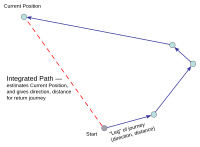
Photo from wikipedia
Objective: The virtual reality (VR)-based path integration task shows substantial promise in predicting dementia risk. However, the reliability and validity in healthy populations need further exploration. The present study investigates… Click to show full abstract
Objective: The virtual reality (VR)-based path integration task shows substantial promise in predicting dementia risk. However, the reliability and validity in healthy populations need further exploration. The present study investigates the relationship between task indicators and brain structures in a healthy population using a VR-based navigation task, particularly the entorhinal cortex (EC) and hippocampus. Methods: Sixty healthy adults were randomly recruited to perform a VR-based path integration task, the digit span task (DST), and an MRI scan. The indicators of the VR-based path integration task were calculated, including the absolute distance error (ADE), degree of angle deviation (DAD), degree of path deviation (DPD), and return time (Time). The reliability of the above indicators was then estimated using the split-half method and Cronbach’s alpha. Correlation and regression analyses were then performed to examine the associations between these indicators and age, general cognitive ability (DST), and brain structural measures. Results: ADE, DAD, and DPD showed reasonable split-half reliability estimates (0.84, 0.81, and 0.72) and nice Cronbach’s alpha estimates (0.90, 0.86, and 0.96). All indicators correlated with age and DST. ADE and DAD were sensitive predictors of hippocampal volume, and return time was a predictor of EC thickness. Conclusion: Our findings demonstrate that the VR-based path integration task exhibits good reliability and validity in the healthy population. The task indicators are age-sensitive, can capture working memory capacity, and are closely related to the integrity of individual EC and hippocampal structures.
Journal Title: Brain Sciences
Year Published: 2022
Link to full text (if available)
Share on Social Media: Sign Up to like & get
recommendations!